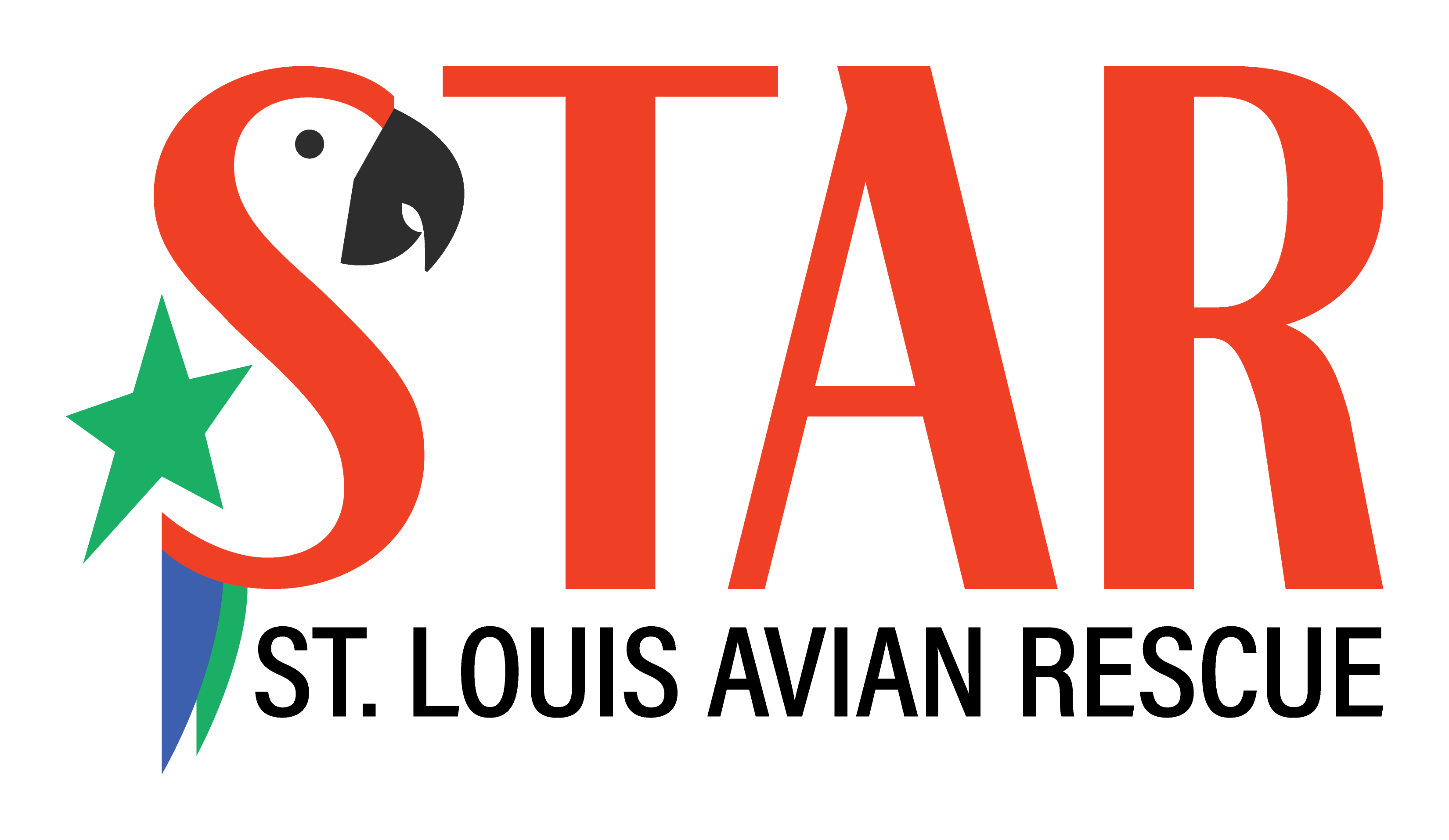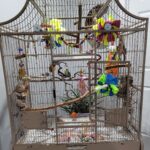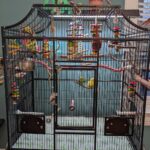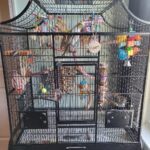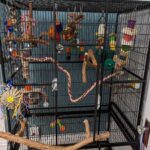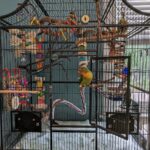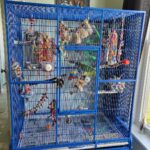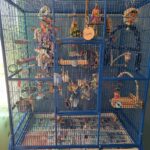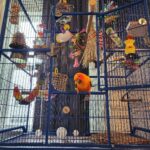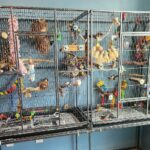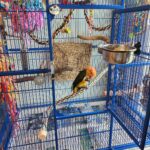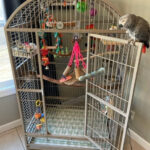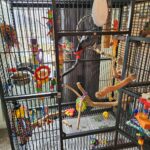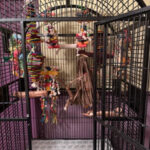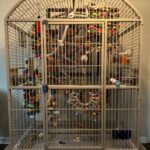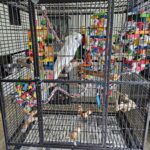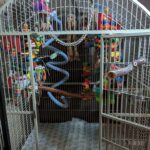Your bird’s home is an important component of their well being. When choosing your bird’s home, it’s important to consider the cage dimensions, overall shape, material and bar spacing. Find our cage guidelines below. And, check out our CAGES 101: Cage Set Up Guide for inspiration on creating an interactive habitat for your feathered friend.
Cage Sizes And Requirements
Finches & Canaries:
MINIMUM REQUIREMENTS: 18” x 30” with ½” bar spacing*
Finches require a cage that will give them ample space to allow flight, which is especially important in this species as they do not navigate their cage space with their beak as parrots do. A general rule of thumb is to get a cage that is wider than it is tall with plenty of room for these little birds to flutter from perch to perch.
Canaries:As with finches and other species that use flight as their primary means of travel, a canary cage should be wide enough to allow for flying back and forth. A cage that is wide enough to have room for the canary to exercise their wings while still providing plenty of room for their perches and toys is a crucial requirement for this species.
*Keep in mind that this requirement will change depending on how many birds are intended for each cage. If there are multiple (or more than two), we recommend nothing smaller than a 32″ x 21″.
Links for a few recommended cages:
https://www.birdscomfort.com/multiple_parakeet_cage.html?search=flight%20cage
https://www.aecageco.com/Products/Flight-Bird-Cages/13221-White-32-21-63-Flight-Bird-Cage-Stand.html
https://www.birdscomfort.com/lovebird-cages.html?search=flight%20cage
https://www.birdscomfort.com/flight_cage.html?search=flight%20cage
Budgies:
MINIMUM REQUIREMENTS: 18” x 24” with ½” bar spacing*
Budgies are an extremely active and playful species and their cage should account for this. Always search for a cage that is more horizontal (instead of tall and narrow) as they tend to utilize this space more. If the budgie(s) is going to be spending more time inside of its cage than out, the larger the cage the better.
*Keep in mind that this requirement is for a single budgie. For pairs, we recommend a 32″ x 21″, or nothing smaller than a 30” x 18” x 18”.
Links for a few recommended cages:
https://www.birdscomfort.com/multiple_parakeet_cage.html?search=flight%20cage
https://www.aecageco.com/Products/Flight-Bird-Cages/13221-White-32-21-63-Flight-Bird-Cage-Stand.html
https://www.birdscomfort.com/lovebird-cages.html?search=flight%20cage
https://www.birdscomfort.com/flight_cage.html?search=flight%20cage
Cockatiels:
MINIMUM REQUIREMENTS: 24″ x 24″ with ½” bar spacing
Common size variations that are also acceptable: 27″ x 24″ or 32″ x 21 with 1/2″ bar spacing
Cockatiels, like many parrots, are hook-billed and use their beaks to climb so their bar spacing should not be too wide. They should also be given plenty of perch variety and toys. Cockatiels in particular are prone to night terrors and this should be kept in mind when determining where their cage will reside. Either covering their cage at night or providing them with a night light will help to lessen the frequency in which cockatiels are startled out of sleep.
Links for a few recommended cages:
https://www.birdscomfort.com/flight_cage.html?search=flight%20cage
https://www.aecageco.com/Products/Flight-Bird-Cages/13221-White-32-21-63-Flight-Bird-Cage-Stand.html
Lovebirds:
MINIMUM REQUIREMENTS: 24″ x 24″ with ½” bar spacing
Common size variations that are also acceptable: 27″ x 24″ or 32″ x 21 with 1/2″ bar spacing
A lovebird’s cage should be roomy and provide lots of activities for the bird to engage in. Toys of varying size, along with perches of varying diameter, should be offered. These little birds are very active and enjoy interacting with all different types of toys, including foraging toys that allow them to keep busy.
Links for a few recommended cages:
https://www.birdscomfort.com/flight_cage.html?search=flight%20cage
https://www.aecageco.com/Products/Flight-Bird-Cages/13221-White-32-21-63-Flight-Bird-Cage-Stand.html
Parrotlets:
MINIMUM REQUIREMENTS: 24″ x 24″ with ½” bar spacing
Common size variations that are also acceptable: 27″ x 24″ or 32″ x 21 with 1/2″ bar spacing
Parrotlets are birds that need a lot of space despite their small size. This is an incredibly active bird that requires a great deal of enrichment in their cage, so toys will be a crucial part of their set up and they should be provided with many different types. Being hook-billed and smaller, they will need narrow bar spacing so that they are able to climb and explore safely.
Links for a few recommended cages:
https://www.birdscomfort.com/flight_cage.html?search=flight%20cage
https://www.aecageco.com/Products/Flight-Bird-Cages/13221-White-32-21-63-Flight-Bird-Cage-Stand.html
Quakers:
MINIMUM REQUIREMENTS: 24″ x 24″ with 1/2” to 5/8″ bar spacing
Common size variations that are also acceptable: 32″ x 21″ with 5/8″ to 3/4″ bar spacing
An intelligent, inquisitive species, quakers require plenty of options for chewing, playing, and perching. These birds are known for being escape artists, so a cage with securely latching doors (including for food and water bowls) will be a necessity to keep them safely contained when unsupervised. As with most parrots, lots of toy and perch options will keep this bird happy. .
Links for a few recommended cages:
https://www.birdscomfort.com/dometop_parrot_cage.html
https://www.birdscomfort.com/flight_cage.html?search=flight%20cage
Conures:
MINIMUM REQUIREMENTS: 24″ x 24″ with 5/8” to 3/4″ bar spacing
Common size variations that are also acceptable: 32″ x 23″ with 5/8″ to 3/4″ bar spacing
Often described as the clowns of the bird world, conures need lots of space to thrive. A cage that offers a wide variety of toys and perches is ideal to keep up with their energetic nature. Conures in particular enjoy toys that allow them to express their naturally playful selves – you will often observe your conure dangling from a boing or a seagrass mat. Their space will need to be filled with lots of options for interaction in order to keep a conure’s energy satisfied.
*Keep in mind that larger conures, like Blue Crowned, Sun, or Nanday conures, may require larger dimensions such as 36″ x 24″ or 48″ x 30″.
Links for a few recommended cages:
https://www.birdscomfort.com/small_flight_cage.html?search=32×21
https://www.birdscomfort.com/?route=product/product&product_id=963&search=flight+cage
Caiques:
MINIMUM REQUIREMENTS: 32″ x 21″ with 5/8″ to ¾” bar spacing
Common size variations that are also acceptable: 36″ x 24″ or 32″ x 23″ with 5/8″ to 3/4″ bar spacing
Another species that is commonly referred to as “clown-like”, caiques enjoy plenty of toys and perches in their cage to support their “on-the-go” personalities. Like conures, these birds hardly ever hold still for more than a few minutes at a time, so their cage should reflect their chaotic personalities. Plenty of variety and stimulation will help to prevent boredom in these interactive birds.
Links for a few recommended cages:
https://www.birdscomfort.com/flight_bird_cage.html?search=32×21
https://www.birdscomfort.com/dometop_parrot_cage.html?search=32×23
Amazons:
MINIMUM REQUIREMENTS: 24″ x 36″ or 30” x 40”with 3/4” to 1″ bar spacing
Common size variations that are also acceptable: 36″ x 28″ or 48″ x 30″ with 3/4″ to 1″ bar spacing
As a more heavy-bodied bird, the Amazon parrot requires a cage of durable construction and bars that are strong enough to allow this bird to navigate its cage without bending. These birds are intelligent and sensitive, so ensuring that they are provided with toys and perches large enough to accommodate their heavier size (and grip) will be essential in their setups.
Links for a few recommended cages:
https://prevuepet.com/product/98/playtop-bird-home–black-3154blk
https://www.birdscomfort.com/large_dometop_cage.html?search=40×30
https://www.aecageco.com/Products/Dome-Top-Cages/9003628-Black-36-28-65-Dome-Top-Bird-Cage.html
African Greys:
MINIMUM REQUIREMENTS: 24″ x 36″ or 30” x 40” with 3/4” to 1″ bar spacing
Common size variations that are also acceptable: 36″ x 28″ or 48″ x 30″ with 3/4″ to 1″ bar spacing
Smart and striking, the African Grey parrot will need lots of opportunities for foraging, exercise, and play in their cage. Different perches in varying size and diameter, offered on different levels of their cage, will help to keep this bird occupied and support their incredible intelligence.
Links for a few recommended cages:
https://prevuepet.com/product/98/playtop-bird-home–black-3154blk
https://www.birdscomfort.com/large_dometop_cage.html?search=40×30
https://www.aecageco.com/Products/Dome-Top-Cages/9003628-Black-36-28-65-Dome-Top-Bird-Cage.html
Goffin’s Cockatoos:
MINIMUM REQUIREMENTS: 30″ x 40″ with 3/4” to 1″ bar spacing
Common size variations that are also acceptable: 36″ x 28″ or 36″ x 48″ with 3/4″ to 1″ bar spacing
A cockatoo cage needs to have enrichment from top to bottom. These birds are extremely playful and love to utilize every inch of their space, so perches and toys need to be offered at all levels. Foraging toys are a particular favorite of this species and highly valued as a tool to encourage mental stimulation and natural behaviors.
Links for a few recommended cages:
https://www.birdscomfort.com/large_dometop_cage.html?search=40×30
https://www.birdscomfort.com/large_bird_cage.html?search=40×30
https://www.birdscomfort.com/double_medium_bird_cage.html?search=36×28
Large Cockatoos:
MINIMUM REQUIREMENTS: 36″ x 48″ with 1” to 1.5″ bar spacing
For a bird this large, the following size would be ideal but not required : 80″ x 40″ with 1″ to 1.5″ bar spacing
The same principles apply in large cockatoo setups as in small cockatoo cages. An interactive, sensitive, and playful species, their cages should support their natural behaviors and include perch and toy variety. Perches that are more suitable for a larger bodied bird should be considered, along with toys that are appropriately sized to appeal to a cockatoo’s sharp beak.
Links for a few recommended cages:
https://www.aecageco.com/Products/Play-Top-Cages/8004836-Black-48-36-76-Play-Top-Bird-Cage.html
Macaws:
MINIMUM REQUIREMENTS: 36″ x 48″ with 1” to 1.5″ bar spacing
For a bird this large, the following size would be ideal but not required : 80″ x 40″ with 1″ to 1.5″ bar spacing
Macaws are the largest of the parrot species and therefore their cage setup should accommodate their size and feather length (their tails alone can measure 24”). Large perches in a variety of diameters should be offered along with toys that are appropriate for their strong beaks. The cage should be durable and made out of a material that a macaw cannot easily break by chewing or climbing.
Links for a few recommended cages:
https://www.birdscomfort.com/play_top_cage.html?search=48×36
Bottom line – the bigger, the better!
